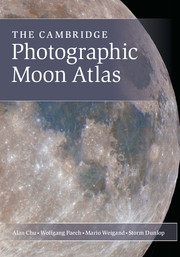Book contents
- Frontmatter
- Preface
- Advice on using this book
- Contents
- The Moon – an introduction
- Atlas of lunar formations
- 1 Mare Smythii
- 2a Mare Crisium
- 2b Mare Crisium
- 3 Cleomedes
- 4 Endymion
- 5 Atlas/Hercules
- 6 Montes Taurus
- 7 Palus Somni
- 8a Mare Fecunditatis
- 8b Mare Fecunditatis
- 9 Langrenus/Petavius
- 10 Mare Australe
- 11 Vlacq
- 12 Vallis Rheita
- 13a Mare Nectaris
- 13b Mare Nectaris
- 14 Rupes Altai
- 15 Abulfeda
- 16 Theophilus
- 17 Sinus Asperitatis
- 18 Statio Tranquillitatis
- 19a Mare Tranquillitatis
- 19b Mare Tranquillitatis
- 20a Mare Serenitatis
- 20b Mare Serenitatis
- 21 Posidonius
- 22 Lacus Mortis
- 23 Aristoteles/Eudoxus
- 24 Montes Caucasus
- 25 Autolycus/Aristillus
- 26 Cassini
- 27 Montes Alpes
- 28 Plato
- 29 Montes Teneriffe
- 30 Archimedes
- 31a Montes Apenninus
- 31b Montes Apenninus
- 32 Mare Vaporum
- 33 Rima Ariadaeus
- 34 Rima Hyginus
- 35 Sinus Medii
- 36 Hipparchus
- 37a Ptolemaeus
- 37b Ptolemaeus
- 38 Rupes Recta
- 39 Regiomontanus
- 40 Maurolycus
- 41 South Pole
- 42 Clavius
- 43 Tycho
- 44 Schiller
- 45 Palus Epidemiarum
- 46 Pitatus
- 47 Mare Nubium
- 48 Fra Mauro
- 49 Mare Cognitum
- 50 Mare Insularum
- 51a Copernicus
- 51b Copernicus
- 52 Eratosthenes
- 53a Mare Imbrium
- 53b Mare Imbrium
- 54 Sinus Iridum
- 55 Gruithuisen
- 56 Mare Frigoris
- 57 North Pole
- 58 Aristarchus
- 59 Kepler
- 60 Seleucus
- 61 Reiner
- 62 Letronne/Hansteen
- 63 Gassendi
- 64 Mare Humorum
- 65 Schickard
- 66 Sirsalis
- 67 Grimaldi
- 68 Mare Orientale
- 69 Lunar Farside
- Glossary
- Index of lunar features
- Image credits
- Further reading and references
53a - Mare Imbrium
Published online by Cambridge University Press: 05 October 2012
- Frontmatter
- Preface
- Advice on using this book
- Contents
- The Moon – an introduction
- Atlas of lunar formations
- 1 Mare Smythii
- 2a Mare Crisium
- 2b Mare Crisium
- 3 Cleomedes
- 4 Endymion
- 5 Atlas/Hercules
- 6 Montes Taurus
- 7 Palus Somni
- 8a Mare Fecunditatis
- 8b Mare Fecunditatis
- 9 Langrenus/Petavius
- 10 Mare Australe
- 11 Vlacq
- 12 Vallis Rheita
- 13a Mare Nectaris
- 13b Mare Nectaris
- 14 Rupes Altai
- 15 Abulfeda
- 16 Theophilus
- 17 Sinus Asperitatis
- 18 Statio Tranquillitatis
- 19a Mare Tranquillitatis
- 19b Mare Tranquillitatis
- 20a Mare Serenitatis
- 20b Mare Serenitatis
- 21 Posidonius
- 22 Lacus Mortis
- 23 Aristoteles/Eudoxus
- 24 Montes Caucasus
- 25 Autolycus/Aristillus
- 26 Cassini
- 27 Montes Alpes
- 28 Plato
- 29 Montes Teneriffe
- 30 Archimedes
- 31a Montes Apenninus
- 31b Montes Apenninus
- 32 Mare Vaporum
- 33 Rima Ariadaeus
- 34 Rima Hyginus
- 35 Sinus Medii
- 36 Hipparchus
- 37a Ptolemaeus
- 37b Ptolemaeus
- 38 Rupes Recta
- 39 Regiomontanus
- 40 Maurolycus
- 41 South Pole
- 42 Clavius
- 43 Tycho
- 44 Schiller
- 45 Palus Epidemiarum
- 46 Pitatus
- 47 Mare Nubium
- 48 Fra Mauro
- 49 Mare Cognitum
- 50 Mare Insularum
- 51a Copernicus
- 51b Copernicus
- 52 Eratosthenes
- 53a Mare Imbrium
- 53b Mare Imbrium
- 54 Sinus Iridum
- 55 Gruithuisen
- 56 Mare Frigoris
- 57 North Pole
- 58 Aristarchus
- 59 Kepler
- 60 Seleucus
- 61 Reiner
- 62 Letronne/Hansteen
- 63 Gassendi
- 64 Mare Humorum
- 65 Schickard
- 66 Sirsalis
- 67 Grimaldi
- 68 Mare Orientale
- 69 Lunar Farside
- Glossary
- Index of lunar features
- Image credits
- Further reading and references
Summary
Mare Imbrium 30.0°N, 20.0°W
Mare Imbrium, the ‘Sea of Showers’ (named by Riccioli) is the dominant feature of the northwestern quadrant of the Moon. With an area of c. 830 000 km2, it is – after Oceanus Procellarum – the second largest mare area on the Moon. Like all the other maria it is the lava-filled central portion of a giant impact basin, 1200 km in diameter.
The mountain range of the Alps, Caucasus, Apennines and Carpathians are the remnants of the outer basin ramparts. Remnants of the inner ramparts are the mountain chains Montes Recti, Montes Spitzbergen, Montes Teneriffe and Mons Pico. Towards the west, in the direction of Oceanus Procellarum, there are no visible signs of the basin walls. Many of the isolated mountain massifs, including those along the norther boundary of Mare Imbrium, and Mons Delisle, are the remnants of former highland regions.
The impact that created the basin was so strong that traces of secondary events are still – even after 3.8 billion years – strikingly visible over the whole of the Moon's nearside. These traces have become known as the Imbrium Sculpture. Particularly strikingly visible are the traces of the Imbrium impact in the trio of craters Ptolemaeus, Alphonsus and Arzachel, and in the area around the crater Julius Caesar. The impacting body probably came from a northwesterly direction.
If the Imbrium Basin is observed when the terminator has passed roughly the centre of the Mare, and thus when the Moon's age is about 8.5 days, it is possible to see the boundary between the second of three lava flows that flooded the Imbrium Basin.
- Type
- Chapter
- Information
- The Cambridge Photographic Moon Atlas , pp. 154 - 155Publisher: Cambridge University PressPrint publication year: 2012



